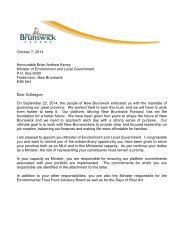cbd-ts-67-en
cbd-ts-67-en
cbd-ts-67-en
- No tags were found...
You also want an ePaper? Increase the reach of your titles
YUMPU automatically turns print PDFs into web optimized ePapers that Google loves.
Annex 2:<br />
Limitations of the data available<br />
Impac<strong>ts</strong> of Marine Debris on Biodiversity: Curr<strong>en</strong>t Status and Pot<strong>en</strong>tial Solutions<br />
The data pres<strong>en</strong>ted in this report are an accurate repres<strong>en</strong>tation of the curr<strong>en</strong>t literature on marine debris. There<br />
are, however, a number of limitations which should be considered wh<strong>en</strong> interpreting the findings pres<strong>en</strong>ted.<br />
The report summarizes impac<strong>ts</strong>, types of debris and i<strong>ts</strong> geographic distribution from data based on repor<strong>ts</strong><br />
in sci<strong>en</strong>tific papers and grey literature. H<strong>en</strong>ce the summary will be influ<strong>en</strong>ced by the frequ<strong>en</strong>cy of impac<strong>ts</strong><br />
themselves and by the frequ<strong>en</strong>cy of reporting. In g<strong>en</strong>eral it should be considered that where species, ecosystems<br />
and types of debris are reported frequ<strong>en</strong>tly, at numerous locations they repres<strong>en</strong>t the most reliable evid<strong>en</strong>ce. It<br />
is reasonable to apply greater caution, however, wh<strong>en</strong> considering impac<strong>ts</strong> that are seldom described, as these<br />
could be a reflection of a lack of reporting. Some examples are outlined below:<br />
Trophic level considerations<br />
Few repor<strong>ts</strong> exist that consider low level trophic<br />
organisms. This report has focused on organisms<br />
from higher trophic levels for which there are more<br />
repor<strong>ts</strong>, in particular mammals, birds, fish and sea<br />
turtles. It is important to note that this does not<br />
indicate that organisms from lower trophic levels<br />
are not impacted by marine debris, only that any<br />
such impac<strong>ts</strong> are, as yet, not fully described. Some<br />
evid<strong>en</strong>ce does exist relating to the ingestion of<br />
microplastics by low trophic level organisms, such<br />
as sea cucumbers, marine worms and detritivours<br />
(Thompson et al., 2004; Graham & Thompson, 2009;<br />
Murray & Cowie, 2011), but further research is<br />
required before the impac<strong>ts</strong> can be fully understood.<br />
Ingestion impac<strong>ts</strong><br />
It is likely that there is an underreporting of<br />
ingestion impac<strong>ts</strong>. Entanglem<strong>en</strong>t effec<strong>ts</strong> are more<br />
widely reported, but this does not necessarily<br />
mean that <strong>en</strong>tanglem<strong>en</strong>t has a larger impact on<br />
biodiversity than ingestion; rather, it reflec<strong>ts</strong> the<br />
fact that <strong>en</strong>tanglem<strong>en</strong>t is more readily observable<br />
and therefore easier to report, whereas ingestion<br />
can only be established by necropsy and studies<br />
are either opportunistic i.e. the discovery of a dead<br />
organism which is th<strong>en</strong> dissected to ascertain cause<br />
of death, or experim<strong>en</strong>tal, where organisms are<br />
tested specifically to assess the ext<strong>en</strong>t to which<br />
they ingest debris.<br />
Consequ<strong>en</strong>ces of ingestion can be indirect<br />
and are difficult to determine (for the reasons<br />
described above), whereas it is comparatively easy<br />
to determine whether <strong>en</strong>tanglem<strong>en</strong>t has directly<br />
led to injury or death.<br />
Invasive species<br />
It is likely that the number of invasive species rafting on<br />
marine debris is underreported. The studies that this<br />
report has id<strong>en</strong>tified have not always specified whether<br />
the species they report are considered invasive.<br />
Study locations<br />
The majority of studies to date have be<strong>en</strong> from on<br />
Europe, North America, and Australasia. This is<br />
unlikely to reflect the true distribution of marine<br />
debris and i<strong>ts</strong> associated impac<strong>ts</strong>, and it should be<br />
recognised that a lack of studies does not necessarily<br />
indicate a lesser impact on biodiversity. Further<br />
studies are therefore required in data defici<strong>en</strong>t areas.<br />
Socio-economic Impact data<br />
There is limited data on the socio-economic impac<strong>ts</strong><br />
of marine debris in the most vulnerable of economies,<br />
and for locations where dep<strong>en</strong>d<strong>en</strong>ce on the sea is<br />
particularly high and fundam<strong>en</strong>tal to local economy<br />
(e.g. tropical sea-based tourism, (semi-)subsist<strong>en</strong>ce<br />
situations in the developing country context etc.). The<br />
literature t<strong>en</strong>ds to have monetary impac<strong>ts</strong> of marine<br />
debris for developed countries, for example based<br />
on fishing industries, but there is limited work on<br />
the socio-economic effec<strong>ts</strong> of marine debris on coral<br />
reef ecosystems, or the consequ<strong>en</strong>ces of degradation<br />
to the economies of developing countries.<br />
Types of debris<br />
This report indicates rope, netting, intact items,<br />
packaging and plastic fragm<strong>en</strong><strong>ts</strong> as being the<br />
main categories of waste implicated in ingestion,<br />
<strong>en</strong>tanglem<strong>en</strong>t and rafting. Plastic items are also the<br />
main types of material reported as debris. In terms<br />
of specific types of debris it will, however, be easier<br />
to observe and report on the impac<strong>ts</strong> from items<br />
that are large and conspicuous, such as rope and<br />
netting. H<strong>en</strong>ce the data pres<strong>en</strong>ted here may under<br />
repres<strong>en</strong>t impac<strong>ts</strong> from less conspicuous types of<br />
debris, such as fragm<strong>en</strong><strong>ts</strong> and microplastics.<br />
61



